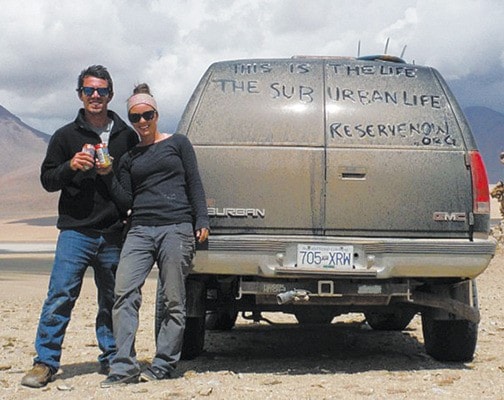What started out as dinnertime conversation between Heather Klein and Marshall Burrows turned into a 10-month odyssey through 15 countries across North and South America.
The couple, both originally from Cranbrook, were living in Calgary and looking to start their respective careers after finishing school when they decided to embark on an epic road trip down to the end of the world—the tip of Argentina.
"The idea was on the table for over a year, but one day he actually was like, 'Do you want to do it?' Klein said, "and I said, 'Yep, lets do it.'
"…We had been sort of thinking about the trip for a while," she added. "We had inherited a Suburban from his [Burrows'] parents and created a bed in the back with storage underneath, which was a perfect way to camp."
The decision made last year, they began to plan.
The Suburban was souped up with a dual-battery system to charge while driving, fans and lights were wired in, while a hookup for a cooler-style fridge was installed.
Underneath the bed was storage space for food, clothing, and an awning.
Hours and hours of internet research went into the process as well to figure out the logistics of travel and vehicle insurance, driving license requirements, budgets and Visas.
They also needed time to save up enough money for the adventure, as they left their condo and moved in with some friends in order to put everything they could into the bank as fast as possible.
"Our determining factor was our bank account," Klein joked. "So we picked a reasonable budget per day that we thought we could work with and that gave us 10 months."
On July 4, 2014, they hit the road.
Determining the route was simple enough—Highway 101 took them down the U.S. coast to the Mexican border before eventually linking up to the Pan-American highway in Central America.
Once they got into the southern end of Mexico, the plan was to spend half their time in Central America and the other half in South America.
"We tried to pick the things we knew we wanted to see and then spend a few days there to fully soak up what we were doing, instead of going through Lonely Planet and picking out the top-10," Klein said.
On the road, the countries seemed to fly by. Starting in Calgary, they headed down the U.S. west coast, into Mexico, Guatemala, El Salvador, Nicaragua, Costa Rica, and Panama, where they hit the biggest challenge of their adventure—getting the truck across the Darien Gap.
The Gap, a large undeveloped and environmentally sensitive area, breaks the connection between the Pan-American Highway in Central and South America.
The plan was to ship the vehicle from Panama into Columbia at a cost of $1,200 and hope that it wasn't the one in three vehicles that turned out to be smashed and stripped when it reached its destination.However, they navigated the proper permitting and documentation process and made it to Columbia.
From there, it was onto Ecuador, Peru, Bolivia, Chile and Argentina.
After reaching their goal, they turned around and headed up to Uruguay, where they sold everything they could—including the truck—and met up with family for a brief holiday together before flying back to Calgary in May 2015.
Along the way there were many highlights. Diving for clams in Ensenada and attending an ancient cleansing ritual in a Tamazcal (sweat lodge) in San Cristabol—both in Mexico.
There was the salt flats in Bolivia and the feeling of accomplishment when they hit Ushuaia—their southern-most point, in Argentina.
Both avid rock climbers, they hit up spots in Guatemala and experienced a 5.4-magnitude earthquake while on a 40-foot rock face in Chile.
However, one of the more enduring memories for Klein was seeing the turtle arribadas—a natural phenomenon where thousands of turtles arrive on a beach to lay their eggs—in Nicaragua.
Some park rangers directed them to a beach where they were anticipating the event, though they didn't know exactly which day it was going to happen.
Klein and Burrows, along with a few friends, went to the one-kilometre long stretch of sand to check it out.
"The two of us and our friends are the only ones on the beach and there are already over 1,000 turtles coming up out of the ocean, up onto the sand and making the holes, laying their eggs, burying them, and coming back to the beach," Klein said.
"In that night, as the sun was setting, more and more turtles were coming up and the park ranger said that over 15,000 turtles were expected to come on this one night."
Now back home and readjusting to the North American lifestyle, the two plan to refill the bank account before dreaming up their next adventure.
Klein blogged about their trip, which can be found at: www.reservenow.org.
